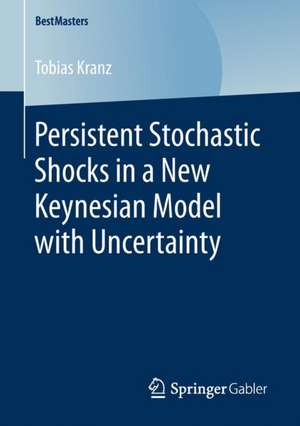Persistent Stochastic Shocks in a New Keynesian Model with Uncertainty: BestMasters
Autor Tobias Kranzen Limba Engleză Paperback – 6 oct 2016
Din seria BestMasters
-
 Preț: 364.13 lei
Preț: 364.13 lei - 13%
 Preț: 367.40 lei
Preț: 367.40 lei -
 Preț: 364.13 lei
Preț: 364.13 lei -
 Preț: 394.30 lei
Preț: 394.30 lei -
 Preț: 393.57 lei
Preț: 393.57 lei -
 Preț: 406.58 lei
Preț: 406.58 lei - 13%
 Preț: 366.14 lei
Preț: 366.14 lei -
 Preț: 367.04 lei
Preț: 367.04 lei -
 Preț: 391.40 lei
Preț: 391.40 lei -
 Preț: 346.23 lei
Preț: 346.23 lei - 13%
 Preț: 364.56 lei
Preț: 364.56 lei -
 Preț: 311.76 lei
Preț: 311.76 lei - 5%
 Preț: 403.95 lei
Preț: 403.95 lei - 13%
 Preț: 396.41 lei
Preț: 396.41 lei -
 Preț: 365.65 lei
Preț: 365.65 lei - 13%
 Preț: 365.82 lei
Preț: 365.82 lei - 13%
 Preț: 367.40 lei
Preț: 367.40 lei -
 Preț: 333.99 lei
Preț: 333.99 lei - 20%
 Preț: 366.22 lei
Preț: 366.22 lei - 13%
 Preț: 368.34 lei
Preț: 368.34 lei -
 Preț: 367.04 lei
Preț: 367.04 lei -
 Preț: 377.18 lei
Preț: 377.18 lei -
 Preț: 365.58 lei
Preț: 365.58 lei -
 Preț: 344.45 lei
Preț: 344.45 lei -
 Preț: 392.12 lei
Preț: 392.12 lei - 20%
 Preț: 292.10 lei
Preț: 292.10 lei -
 Preț: 404.04 lei
Preț: 404.04 lei -
 Preț: 251.33 lei
Preț: 251.33 lei -
 Preț: 393.57 lei
Preț: 393.57 lei -
 Preț: 344.87 lei
Preț: 344.87 lei -
 Preț: 410.77 lei
Preț: 410.77 lei -
 Preț: 411.75 lei
Preț: 411.75 lei -
 Preț: 379.30 lei
Preț: 379.30 lei -
 Preț: 411.32 lei
Preț: 411.32 lei -
 Preț: 412.89 lei
Preț: 412.89 lei -
 Preț: 377.73 lei
Preț: 377.73 lei -
 Preț: 378.12 lei
Preț: 378.12 lei -
 Preț: 412.51 lei
Preț: 412.51 lei -
 Preț: 481.79 lei
Preț: 481.79 lei -
 Preț: 377.18 lei
Preț: 377.18 lei -
 Preț: 480.06 lei
Preț: 480.06 lei -
 Preț: 376.04 lei
Preț: 376.04 lei -
 Preț: 382.95 lei
Preț: 382.95 lei -
 Preț: 377.95 lei
Preț: 377.95 lei -
 Preț: 412.68 lei
Preț: 412.68 lei -
 Preț: 376.80 lei
Preț: 376.80 lei -
 Preț: 380.45 lei
Preț: 380.45 lei -
 Preț: 410.17 lei
Preț: 410.17 lei -
 Preț: 410.94 lei
Preț: 410.94 lei -
 Preț: 380.63 lei
Preț: 380.63 lei
Preț: 375.23 lei
Nou
Puncte Express: 563
Preț estimativ în valută:
71.80€ • 75.17$ • 59.41£
71.80€ • 75.17$ • 59.41£
Carte tipărită la comandă
Livrare economică 07-21 aprilie
Preluare comenzi: 021 569.72.76
Specificații
ISBN-13: 9783658156381
ISBN-10: 3658156384
Pagini: 86
Ilustrații: XIII, 72 p. 19 illus.
Dimensiuni: 148 x 210 x 5 mm
Greutate: 0.11 kg
Ediția:1st ed. 2017
Editura: Springer Fachmedien Wiesbaden
Colecția Springer Gabler
Seria BestMasters
Locul publicării:Wiesbaden, Germany
ISBN-10: 3658156384
Pagini: 86
Ilustrații: XIII, 72 p. 19 illus.
Dimensiuni: 148 x 210 x 5 mm
Greutate: 0.11 kg
Ediția:1st ed. 2017
Editura: Springer Fachmedien Wiesbaden
Colecția Springer Gabler
Seria BestMasters
Locul publicării:Wiesbaden, Germany
Cuprins
Historical recapitulation of DSGE Modeling.- Derivation of a basic New Keynesian Model.- Augmentation with persistent shocks and uncertainty.- Comparative statics and a wide range of numerical simulations.- Mathematical concepts and background information in the appendix.
Notă biografică
Tobias Kranz obtained his Master of Science degree in Economics at the University of Trier in 2015. He has been working as postgraduate at the chair of Empirical Economics (University of Trier) since 2016.
Textul de pe ultima copertă
The book introduces the New Keynesian framework, historically through a literature overview and through a step-by-step derivation of a New Keynesian Phillips curve, an intertemporal IS curve, and a targeting rule for the central bank. This basic version is then expanded by introducing cost and demand shocks and uncertainty. The latter enters the model via second order Taylor approximation instead of linearization. Bringing all equations together results in an equilibrium condition which is simulated with a wide range of parameter values, including possible crisis scenarios. The author finds that accounting for uncertainty – regarding growth and inflation expectations – can lead to lower nominal interest rates set by the central bank.
Contents
· Historical recapitulation of DSGE Modeling
· Derivation of a basic New Keynesian Model
· Augmentation with persistent shocks and uncertainty
· Comparative statics and a wide range of numerical simulations
· Mathematical concepts and background information in the appendix
Target Groups
· Researchers and graduate students in macroeconomics and monetary policy
· Managers and practitioners in the fields of monetary economics
The Author
Tobias Kranzobtained his Master of Science degree in Economics at the University of Trier in 2015. He has been working as postgraduate at the chair of Empirical Economics (University of Trier) since 2016.
Contents
· Historical recapitulation of DSGE Modeling
· Derivation of a basic New Keynesian Model
· Augmentation with persistent shocks and uncertainty
· Comparative statics and a wide range of numerical simulations
· Mathematical concepts and background information in the appendix
Target Groups
· Researchers and graduate students in macroeconomics and monetary policy
· Managers and practitioners in the fields of monetary economics
The Author
Tobias Kranzobtained his Master of Science degree in Economics at the University of Trier in 2015. He has been working as postgraduate at the chair of Empirical Economics (University of Trier) since 2016.
Caracteristici
Study in the field of economics Introduction of the New Keynesian framework Mathematical concepts and background information Includes supplementary material: sn.pub/extras












